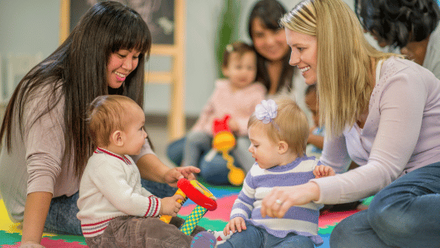The importance of information sharing to protect children from harm
Building meaningful relationships and strong partnerships both with children and their families is integral to the impact we can have in a child’s formative years and initial experience of education. Our professionality is built on the foundations of communication and an ability to use interpersonal skills to relate to challenging situations, celebrate moments of happiness, and to provide a consistent and friendly face that supports children and their families throughout their time in early education and care.
But our communication skills are needed on a much broader level throughout the work we do. Sometimes, this relates to our primary role to safeguard children, communicating accurately with colleagues and multiple agencies to ensure the welfare of children is sustained at all times. Information sharing is key to provide efficient and maintained safeguarding for all children, so that no child’s needs go unheard.
In this article, we are going to look at some of the ways to promote information-sharing and understand why everyone has an important part within the communication thread.
What do we mean by information sharing?
We share our information all the time – every time we log into social media or use our bank account. But what does information sharing mean when it comes to early education and care, and what implication does it have for keeping children safe?
Everyone is protected by data protection laws, but there is a clause to highlight that personal data can be accessed and shared if on a ‘lawful basis’. Put simply, if there is a justified cause for concern relating to protecting individuals from harm.
In this respect, though data sharing is strictly prohibited on a day-to-day basis, organisations have the authority to pass on sensitive information when it comes to safeguarding children. This is because the role of information sharing within safeguarding is so vital to ensuring safety for all that the benefits outweigh the risks enough to be a justified action.
Information sharing might take the form of:
-
Doctors sharing medical information about a child’s injuries with child protection services because it causes a concern for the child’s physical welfare.
-
An early education and care provision sharing information about accident logs of minor injuries over a sustained period of time to contribute to building a more detailed picture of these injuries. They might also share a record of attendance at nursery.
-
A health visitor working in the community might share observations made whilst in the household on visits, including the family dynamics and where concerns might have arisen from the home environment and areas of risk.
-
A midwife involved with the pregnancy of the child and subsequent post-natal care could share important information about the mother’s mental health and assess the family capacity and potential need for additional support.
All four of these professionals have a duty of care to act on concerns where a child’s welfare in concerned. By sharing the information they have, from their varied perspectives, they all work together to give a clearer and more complex picture of the circumstances involved in this child’s situation and allows for better reasoning when it comes to making decisions on how to proceed.
Why is information sharing important?
Information sharing is key to our duty in safeguarding. With so many various roles across the child protection services, it would be impossible for one person to retain all the insights needed to make a well-rounded judgement on a child’s welfare.
By sharing our perspectives as individual professionals, child protection services are able to gain a deeper and more substantial insight into a child’s circumstances and where any concerns might need further investigation or action taken.
Case reviews such as this one constantly highlight the need for better information sharing processes and linked-up discussions where concerns arise with children. Distressing stories surrounding failings of safeguarding are all too common on our newsfeeds and a common theme that continues to emerge surrounds how professional communicate their concerns for a child’s welfare. This is why it is so important that early education and care professionals use their unique position in the lives of young children to act on worries immediately and share information with relevant agencies.
So how do we implement effective information sharing?
The Think. Check. Share campaign is a new campaign designed to myth-bust the data protection worries that often prevent people from sharing information. We all have a responsibility to share information when it comes to protecting children from harm.
The Information Commissioner’s Office recently published a 10-step guide to lawfully sharing information for safeguarding purposes. We are going to focus on three of those today to highlight some of the ways information sharing is integral to your role in early education and care.
Lawful basis
We are able to share personal information with relevant parties if it is done to safeguard a child – this is referred to as a ‘lawful basis’. There are six types of lawful basis but it is only required to meet one of them to share the data. The most common lawful basis used in matters of safeguarding are public task (public interest), legal obligation (compliance with law) or legitimate interest.
Ensuring we have a lawful basis to share information helps to decide where our concerns arise from and to make sure we are acting legitimately in the best interests of the child.
Only sharing where necessary
All safeguarding matters are personal and confidential and must be held with the highest level of discretion and privacy. It is imperative that information is only shared with the necessary people to protect all involved and to preserve the accuracy of the information passed on. If a case poses a legitimate cause for concern, any evidence communicated within these processes becomes vital for deciding what happens next so it’s critical that the information is dealt with securely, sensitively and directly.
Share objectively
In safeguarding instances, it can be emotionally challenging to relay information and detach your role working with a child from the feelings and relationship you have. However, when it comes to any kind of reporting in safeguarding, all accounts must be objective and unbiased in order to remain factual and allow an impartial judgement to be made. If you are involved in sharing information, ensure all information passed on is factual, rather than based on interpretations from those initially reporting. Where possible, use direct quotations.
For example, writing ‘Child A was crying and shaking involuntarily’ compared to ‘Child A was so upset they couldn’t control themselves'.
Key takeaways
Information sharing is one of the most important roles we can play as just one part of the wider early education and care sector. By working together with other agencies to communicate concerns and share professional judgments based on sustained observations, we can all contribute to making sure all children can grow up happy and healthy.




